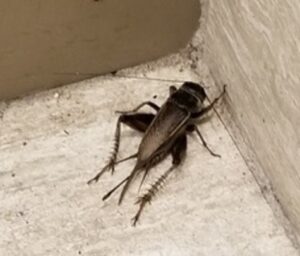Field Crickets

Field Cricket
Field crickets seem to be popping up in large numbers in Central Texas lately and the big question that I receive is WHY? Adults are out and about in the fall because it’s mating season and they need to mate and lay eggs before they die from old age or cold winter temperatures. Crickets overwinter as eggs in the soil.
Field crickets are about 1” long when fully grown and dark brown to black in color with large hind legs used for jumping. They also have two cerci, or appendages that come off the tip of the abdomen. Female crickets have a large sword-like structure, the ovipositor, protruding from the tip of the abdomen (see image). The ovipositor is used to deposit eggs into soil.
Crickets feed on plant material as well as other insects. They can cause damage to seedlings and sometimes large populations can be destructive. Large masses of dead crickets around doorways or other areas can be distasteful to view and cause a foul odor.
Field crickets are primarily outdoor insects but may occasionally venture indoors. When crickets do come indoors, they may bother residents with their chirping. Males chirp to attract a mate creating the sound by rubbing their forewings together.
Cricket management is more easily accomplished in the summer when nymphs, who cannot fly, are present. Unfortunately, this usually isn’t when large populations of crickets are discovered.
Before turning to pesticides to manage your cricket problems, try these ideas:
- Turn off outside lights at night or use bulbs that are less attractive to insects
- Seal cracks & crevices where insects can enter structures with sealant
- Remove debris stacked near the structure
- Keep lawn & surrounding areas mowed
- Stuff weep holes with copper mesh
Fortunately, “cricket season” usually lasts around 4-6 weeks so they won’t be here forever….until next year.
For more information or help with identification, contact Wizzie Brown, Texas A&M AgriLife Extension Service Program Specialist at ebrown@ag.tamu.edu.
This work is supported in part by the Crop Protection and Pest Management, Extension Implementation Program [award no. 2021- 70006-35347/project accession no. 1027036] from the United States Department of Agriculture (USDA) National Institute of Food and Agriculture.
The information given herein is for educational purposes only. Reference to commercial products or trade names is made with the understanding that no discrimination is intended and no endorsement by Texas AgriLife Extension Service or the Texas AgriLife Research is implied. Extension programs serve people of all ages regardless of socioeconomic level, race, color, sex, religion, disability, or national origin.